Microstrip Antenna with High Gain and Strong Directivity Loaded with Cascaded Hexagonal Ring-Shaped Metamaterial
Abstract
:1. Introduction
2. Design and Simulation of Antenna
2.1. Design of Cascaded Hexagonal Ring-Shaped Structure
2.2. Cascaded Hexagonal Ring-Shaped Metamaterial Slot Microstrip Antenna
2.3. Nested Double-Hexagon Ring-Shaped Metamaterial Slot Microstrip Antenna
3. Simulation Results and Analysis
3.1. Property Analysis of Cascaded Hexagonal Ring-Shaped Structure
3.2. Two Types of Cascaded Hexagonal Ring
4. Conclusions
Author Contributions
Funding
Institutional Review Board Statement
Informed Consent Statement
Data Availability Statement
Conflicts of Interest
References
- Popov, A.K.; Nefedov, I.S.; Myslivets, S.A.; Shalaev, M.I.; Slabko, V.V. Nonlinear-Optical Negative-Index Metamaterials: Extraordinary Properties and Applications. In Proceedings of the 2nd International conference, Alushta, Ukraine, 17–22 September 2013. [Google Scholar]
- Li, Y.; Kita, S.; Muñoz, P.; Reshef, O.; Vulis, D.I.; Yin, M.; Lončar, M.; Mazur, E. On-chip zero-index metamaterials. Nat. Photon. 2015, 9, 738–742. [Google Scholar] [CrossRef]
- Viet, D.T.; Hien, N.T.; Tuong, P.V.; Minh, N.; Trang, P.; Le, L.; Lee, Y.; Lam, V. Perfect absorber metamaterials: Peak, multi-peak and broadband absorption. Opt. Commun. 2014, 322, 209–213. [Google Scholar] [CrossRef]
- Smith, D.R.; Pendry, J.B.; Wiltshire, M.C.K. Metamaterials and Negative Refractive Index. Science 2004, 305, 788–792. [Google Scholar] [CrossRef] [Green Version]
- Huangfu, J.; Ran, L.; Chen, H.; Zhang, X.-M.; Chen, K.; Grzegorczyk, T.M.; Kong, J.A. Experimental confirmation of negative refractive index of a metamaterial composed of Ω-like metallic patterns. Appl. Phys. Lett. 2004, 84, 1537–1539. [Google Scholar] [CrossRef]
- Chen, H.; Ran, L.; Huangfu, J.; Zhang, X.; Chen, K.; Grzegorczyk, T.M.; Kong, J.A. Metamaterial exhibiting left-handed properties over multiple frequency bands. J. Appl. Phys. 2004, 96, 5338–5340. [Google Scholar] [CrossRef]
- Guo, Y.; Zhang, X. Design and simulation of a simple two-dimensional left-handed material. J. Phys. 2010, 59, 8584–8590. [Google Scholar]
- Chen, C.; Qu, S.; Xu, Z.; Wang, J.; Ma, H.; Zhou, H. Two-dimensional broadband left-handed materials based on one-sided metal structure. J. Phys. 2011, 60, 249–253. [Google Scholar]
- Cheng, Z.; Liang, C.H.; Li, L. Broadband negative index metamaterials with low-loss. AEUE—Int. J. Electron. Commun. 2011, 65, 724–727. [Google Scholar]
- Yang, C.; Zhang, H.; Wang, H.; Xu, N.; Xu, Y.; Huang, L.; Zhang, K. Cross-ring left-handed material unit structural design and simulation. J. Phys. 2012, 61, 177–185. [Google Scholar]
- He, Z.; Geng, Y. A wideband low-loss and small size left-handed metamaterial. In Proceedings of the 2015 IEEE 16th International Conference on Communication Technology, Hangzhou, China, 18–20 October 2015; pp. 667–669. [Google Scholar]
- Li, B.; Wu, B.; Liang C, H. High Gain Circular Waveguide Array Antenna Using Electromagnetic Band-gap Structure. J. Electromagn. Waves Appl. 2005, 20, 955–966. [Google Scholar] [CrossRef]
- Li, B.; Wu, B.; Liang C, H. Study on High Gain Circular Waveguide Array Antenna with Metamaterial Structure. Prog. Electromagn. Res. 2006, 60, 207–219. [Google Scholar] [CrossRef] [Green Version]
- Liang, L.; Li, B.; Liu, S.-H.; Liang, C.-H. A Study of Using the Double Negative Structure to Enhance the Gain of Rectangular Waveguide Antenna Arrays. Prog. Electromagn. Res. 2006, 65, 275–286. [Google Scholar] [CrossRef] [Green Version]
- Dash, R.K.; Sahu, S.K.; Mishra, C.S.; Sethi, K.; Palai, G.; Sahu, S. Realization of ’non-linear invisibility cloak’ using meta-material. Optik 2016, 127, 9635–9639. [Google Scholar] [CrossRef]
- Liu, G.-C.; Li, C.; Fang, G.-Y. Experimental demonstration of an invisible cloak with irregular shape by using tensor transmission line metamaterials. Chin. Phys. B 2015, 24, 014101. [Google Scholar] [CrossRef]
- Wu, B.I.; Wang, W.; Pacheco, J.; Chen, X.; Grzegorczyk, T.M.; Kong, J. A study of using metamaterials as antenna substrate to enhance gain. Prog. Electromagn. Res. 2005, 51, 295–328. [Google Scholar] [CrossRef] [Green Version]
- Cao, W.; Qian, Z.; Zhang, B.; Chen, Z.N. Applications of metamaterials-based microstrip antennas. In Proceedings of the 2014 3rd Asia-Pacific Conference on Antennas and Propagation, Harbin, China, 26–29 July 2014; pp. 77–80. [Google Scholar]
- Pendry, J.B. New lenses for imaging the near field. In Proceedings of the Digest Quantum Electronics and Laser Science Conference, Baltimore, MD, USA, 1–6 June 2003. [Google Scholar]
- Xu, Y.; Fu, Y.; Lin, X.; Chen, H. Conjugate metamaterials and the perfect lens. Physics 2015, 1510, 08638. [Google Scholar]
- Zhou, B.C.; Wang, D.H.; Ma, J.J.; Li, B.Y.; Zhao, Y.J.; Li, K.X. An ultrathin and broadband radar absorber using metamaterials. Waves Random Complex Media 2019, 1–10. [Google Scholar] [CrossRef]
- Zhang, Y.; Duan, J.; Zhang, B.; Zhang, W.; Wang, W. A flexible metamaterial absorber with four bands and two resonators. J. Alloy. Compd. 2017, 705, 262–268. [Google Scholar] [CrossRef]
- Engheta, N. An idea for thin subwavelength cavity resonators using metamaterials with negative permittivity and permeability. IEEE Antennas Wirel. Propag. Lett. 2002, 1, 10–13. [Google Scholar] [CrossRef] [Green Version]
- Bilotti, F.; Alu, A.; Vegni, L. Design of Miniaturized Metamaterial Patch Antennas With miu-Negative Loading. IEEE Trans. Antennas Propag. 2008, 56, 1640–1647. [Google Scholar] [CrossRef]
- Cao, W.; Zhang, B.; Liu, A.; Yu, T.; Guo, D.; Wei, Y. Broadband High-Gain Periodic Endfire Antenna by Using I-Shaped Resonator (ISR) Structures. IEEE Antennas Wirel. Propag. Lett. 2012, 11, 1470–1473. [Google Scholar]
- Sun, Y.H.; Wen, G.; Jin, H.Y.; Wang, P.; Huang, Y.J. Gain enhancement for wide bandwidth endfire antenna with I-shaped resonator (ISR) structures. Electron. Lett. 2013, 49, 736–737. [Google Scholar] [CrossRef]
- Gupta, M.; Mathur, V. Koch boundary on the square patch microstrip antenna for ultra wideband applications. Alex. Eng. J. 2018, 57, 2113–2122. [Google Scholar] [CrossRef]
- Ma, B.; Yang, X.-M.; Li, T.-Q.; Du, X.-F.; Yong, M.-Y.; Chen, H.-Y.; He, H.; Chen, Y.-W.; Lin, A.; Chen, J.; et al. Gain enhancement of transmitting antenna incorporated with double-cross-shaped electromagnetic metamaterial for wireless power transmission. Optik 2016, 127, 6754–6762. [Google Scholar] [CrossRef]
- Gao, X.J.; Tong, C.; Li, Z. Enhancement of gain and directivity for microstrip antenna using negative permeability metamaterial. AEUE—Int. J. Electron. Commun. 2016, 70, 880–885. [Google Scholar] [CrossRef]
- Liu, M.; Zhang, B.; Duan, J. A broadband directional microstrip antenna based on metamaterial. Chin. J. Mech. Eng. 2018, 54, 64–68. [Google Scholar] [CrossRef]

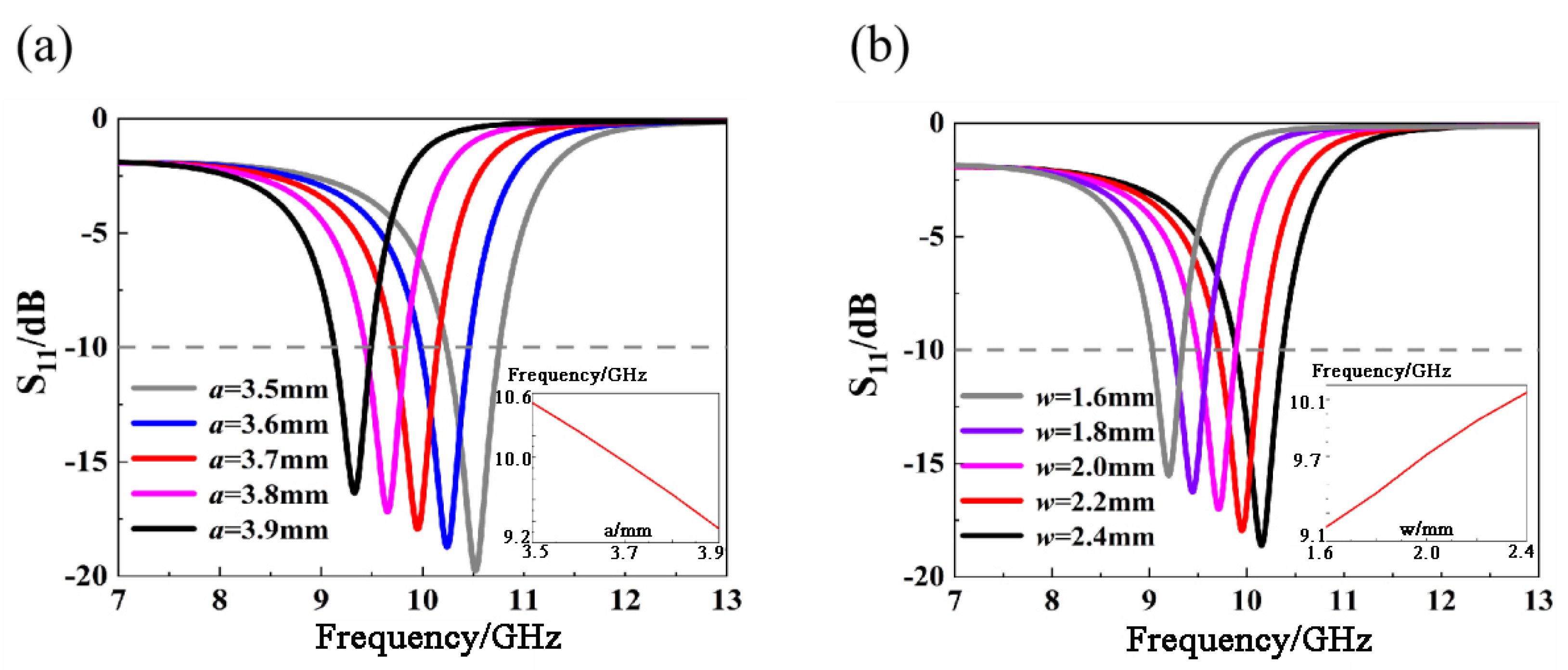
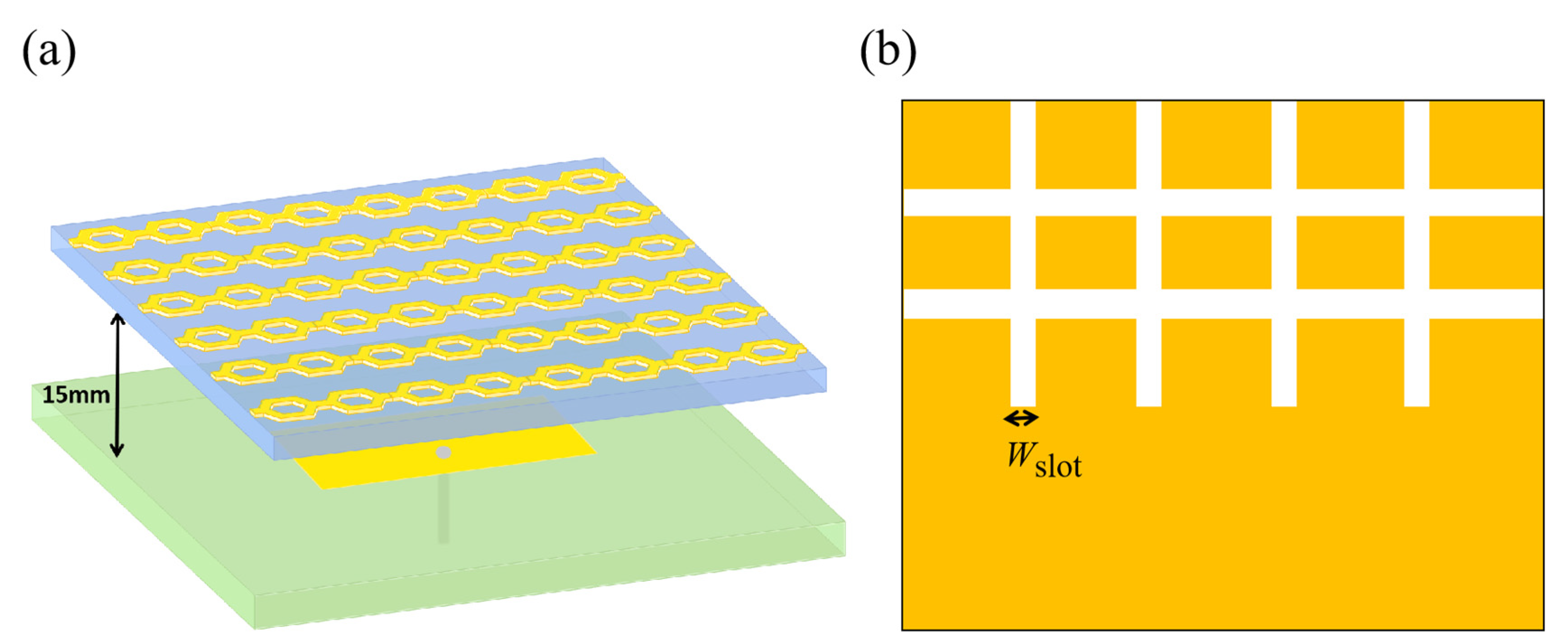
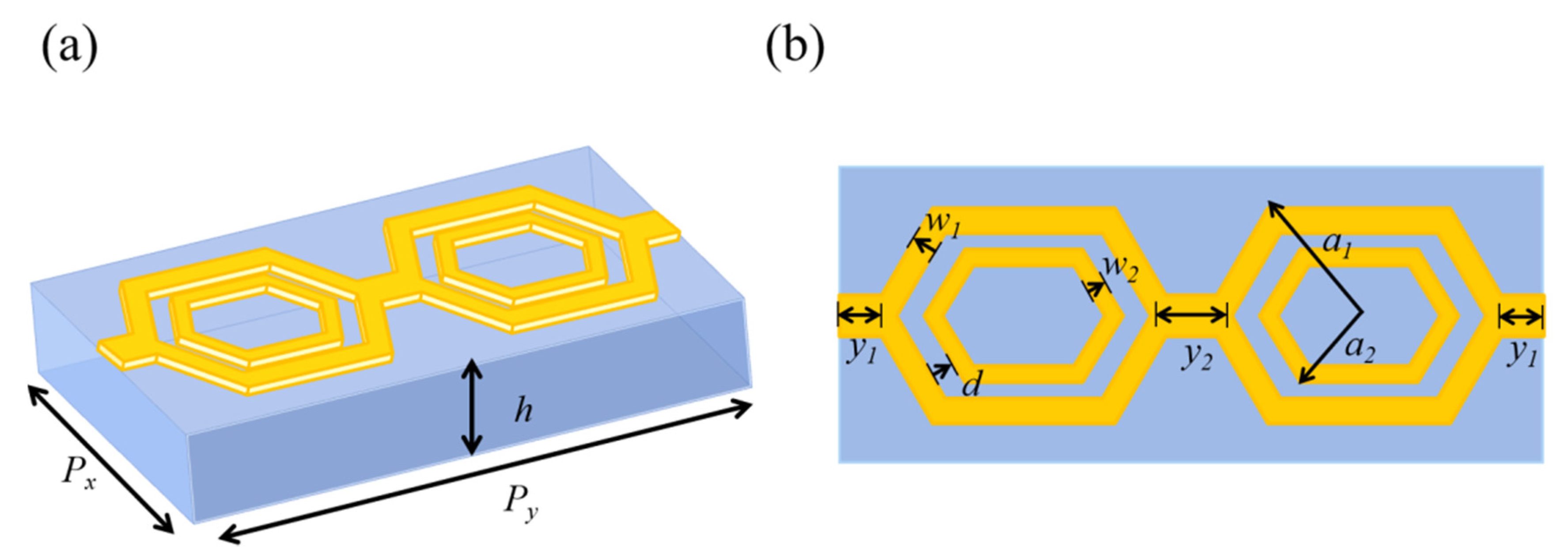
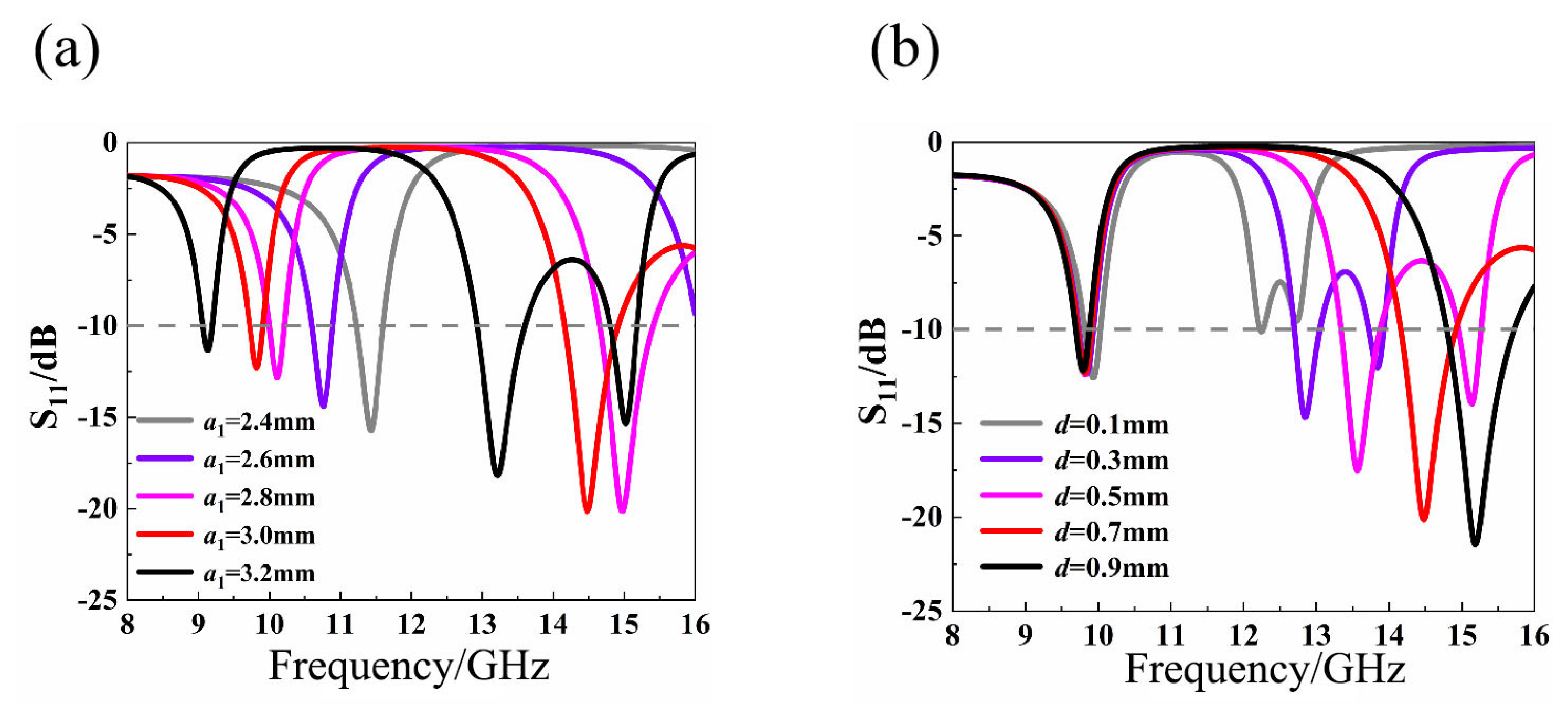
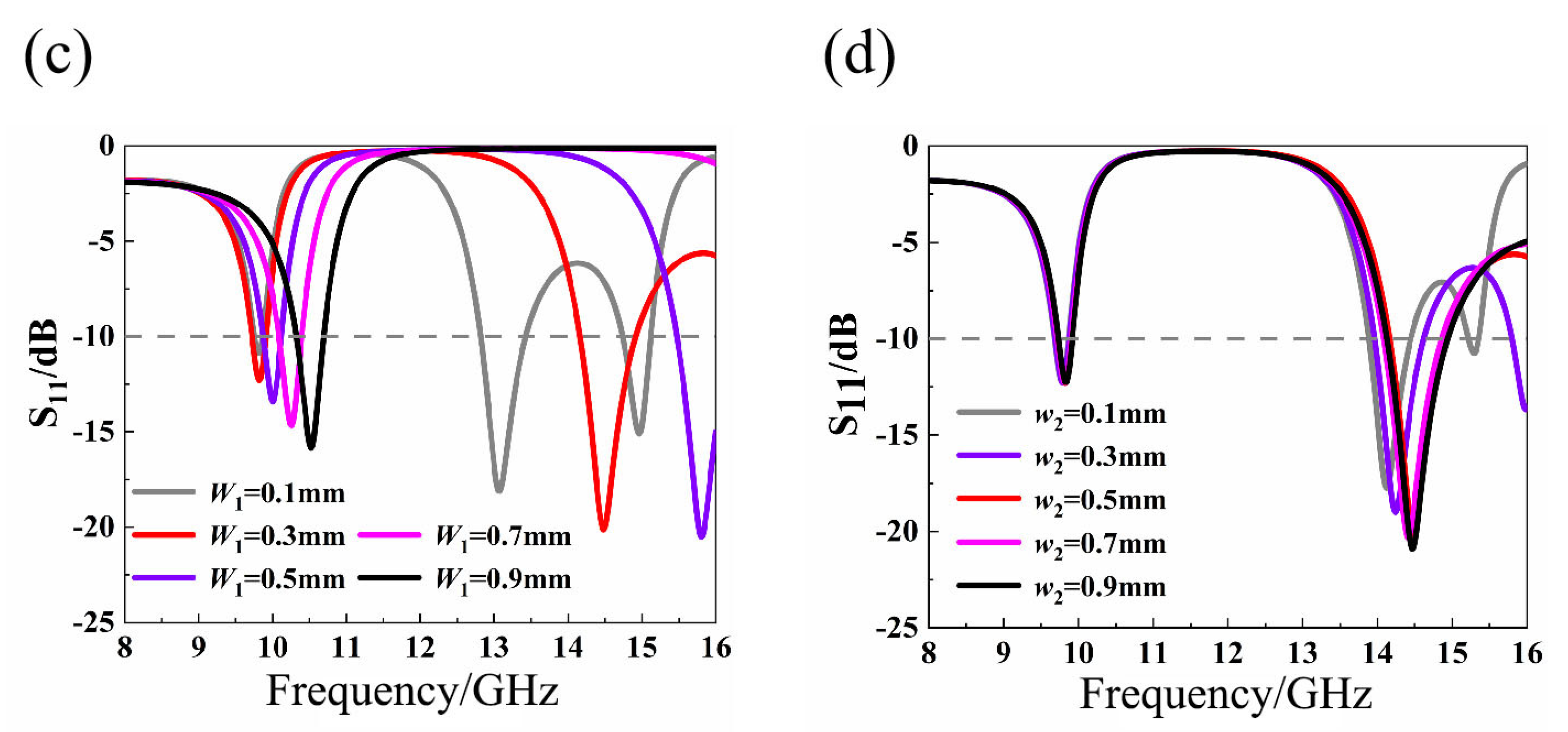
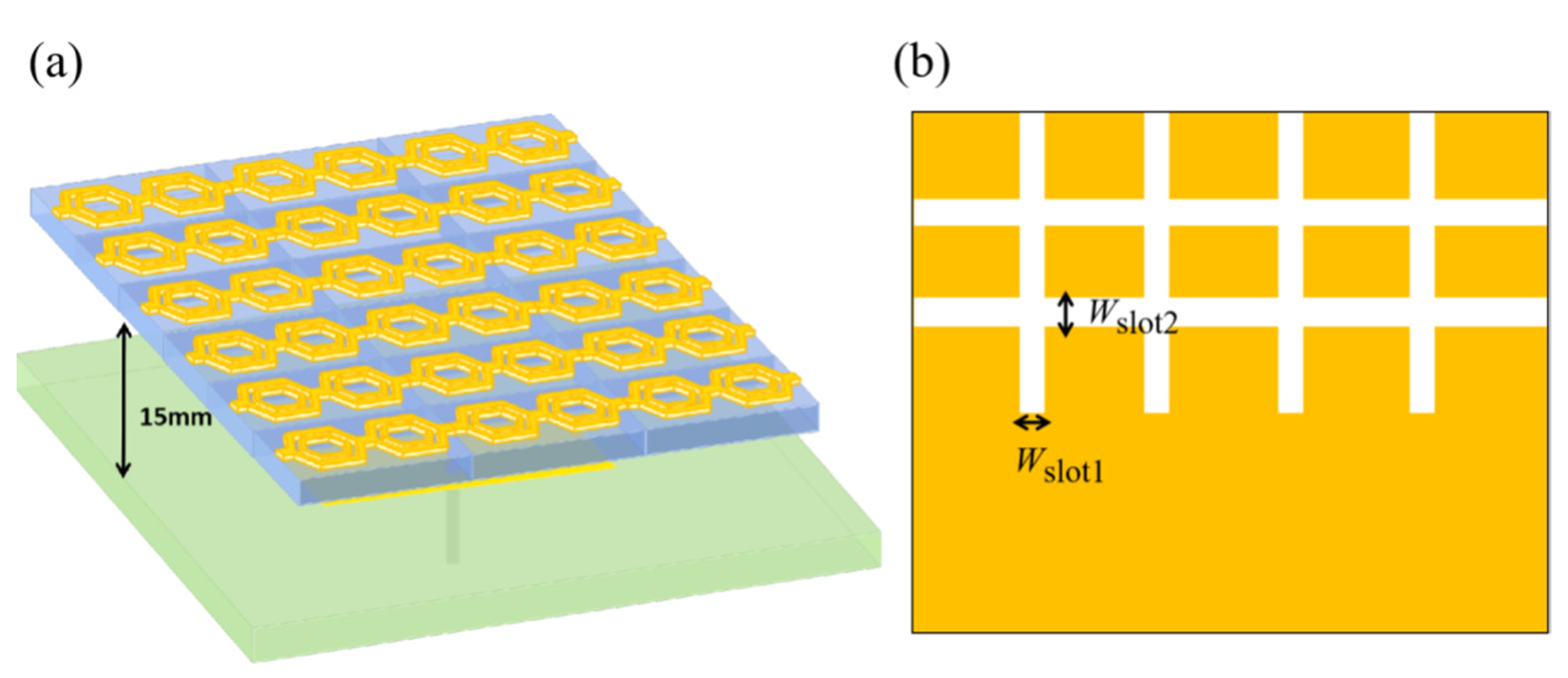
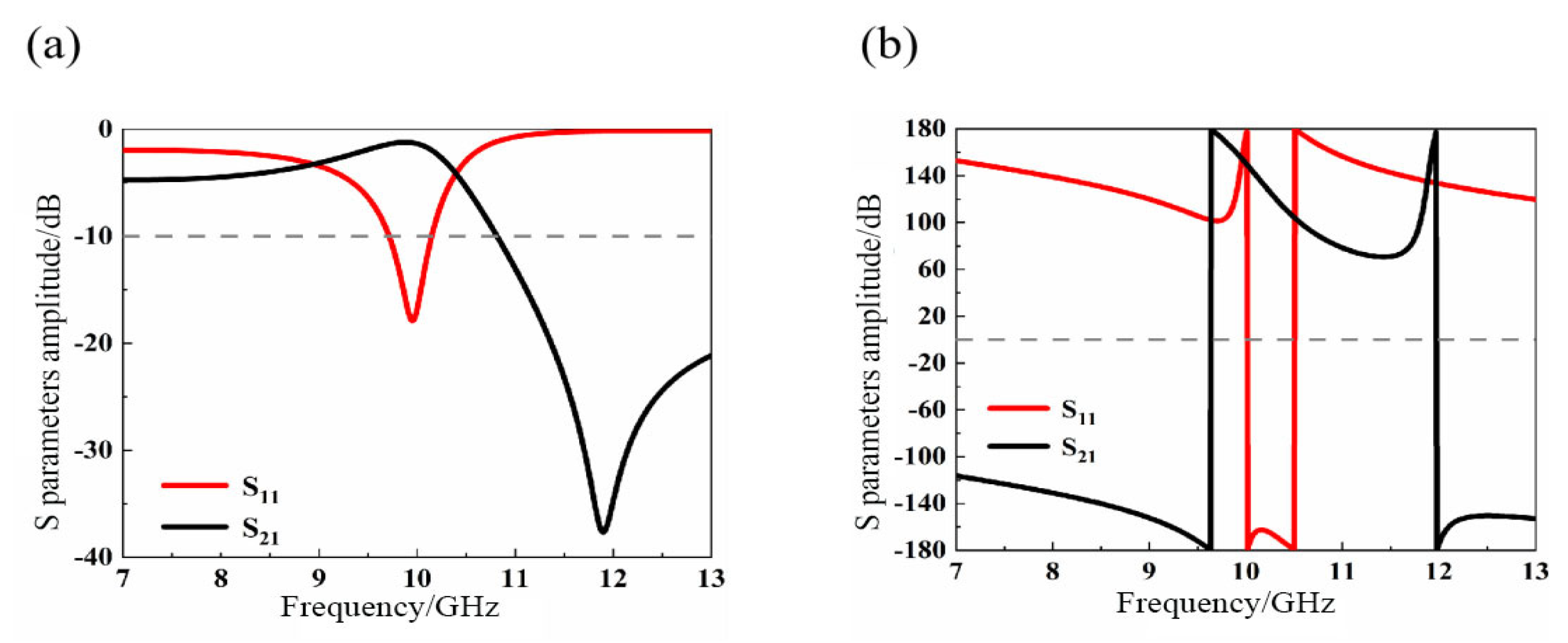
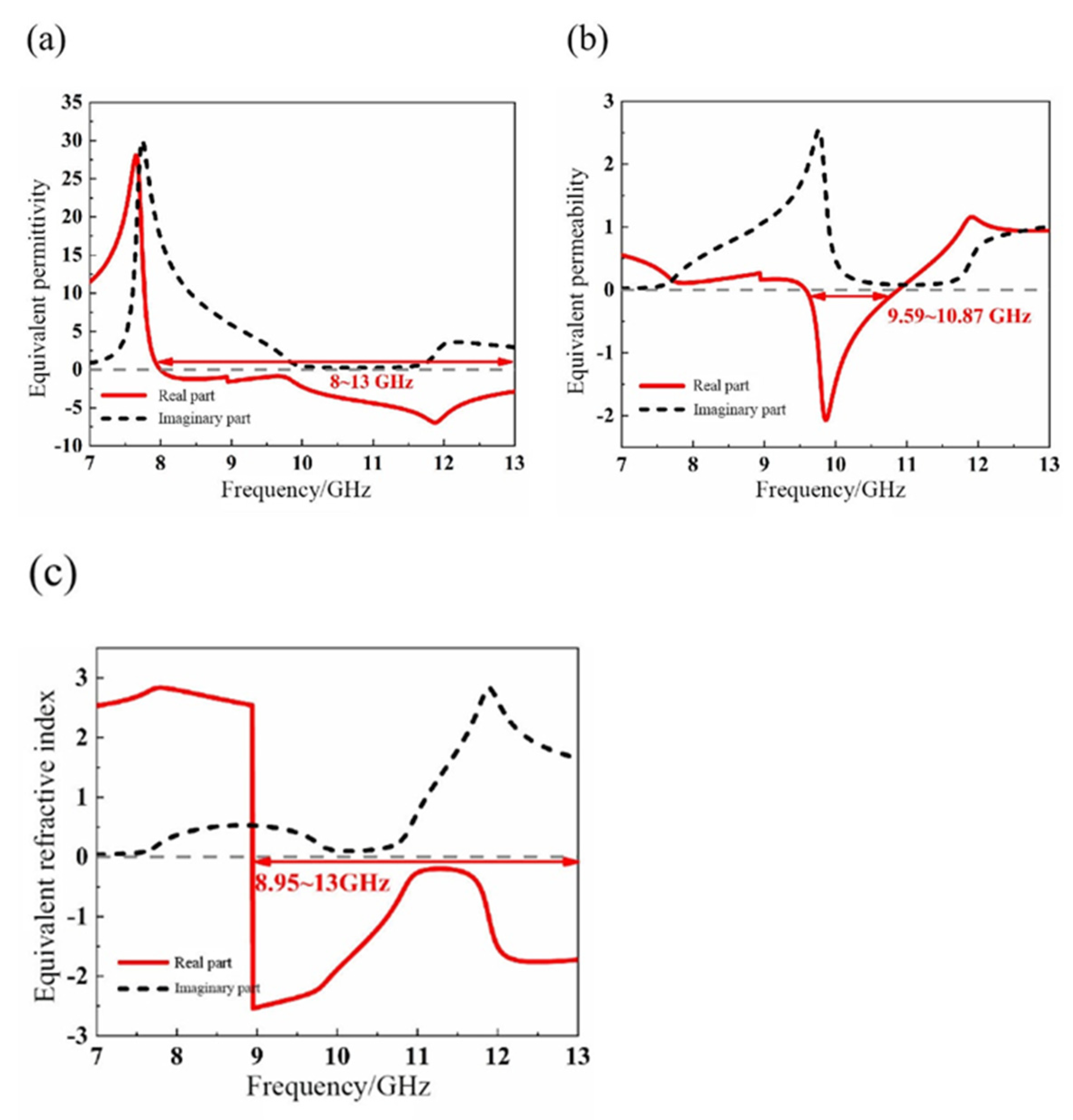
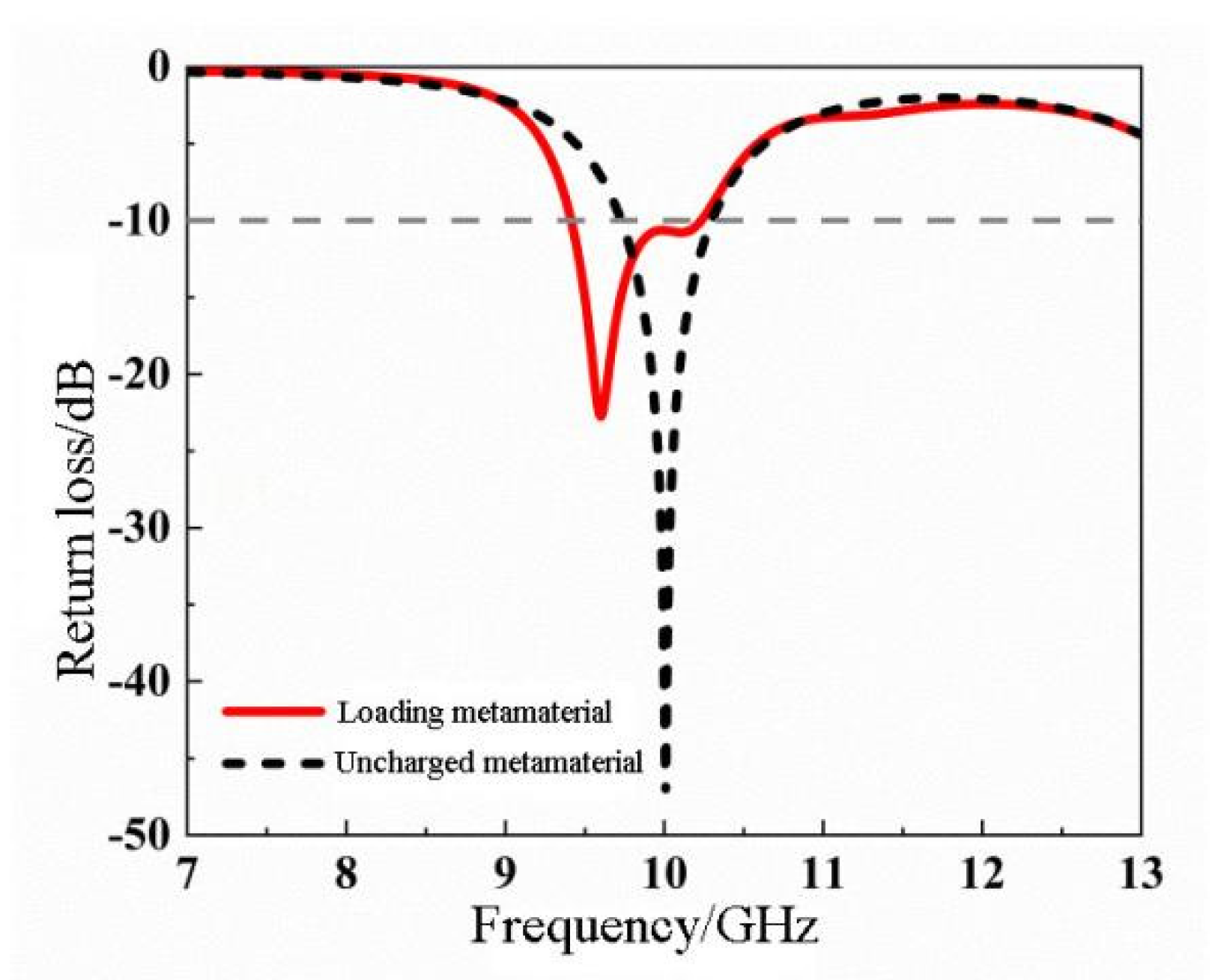


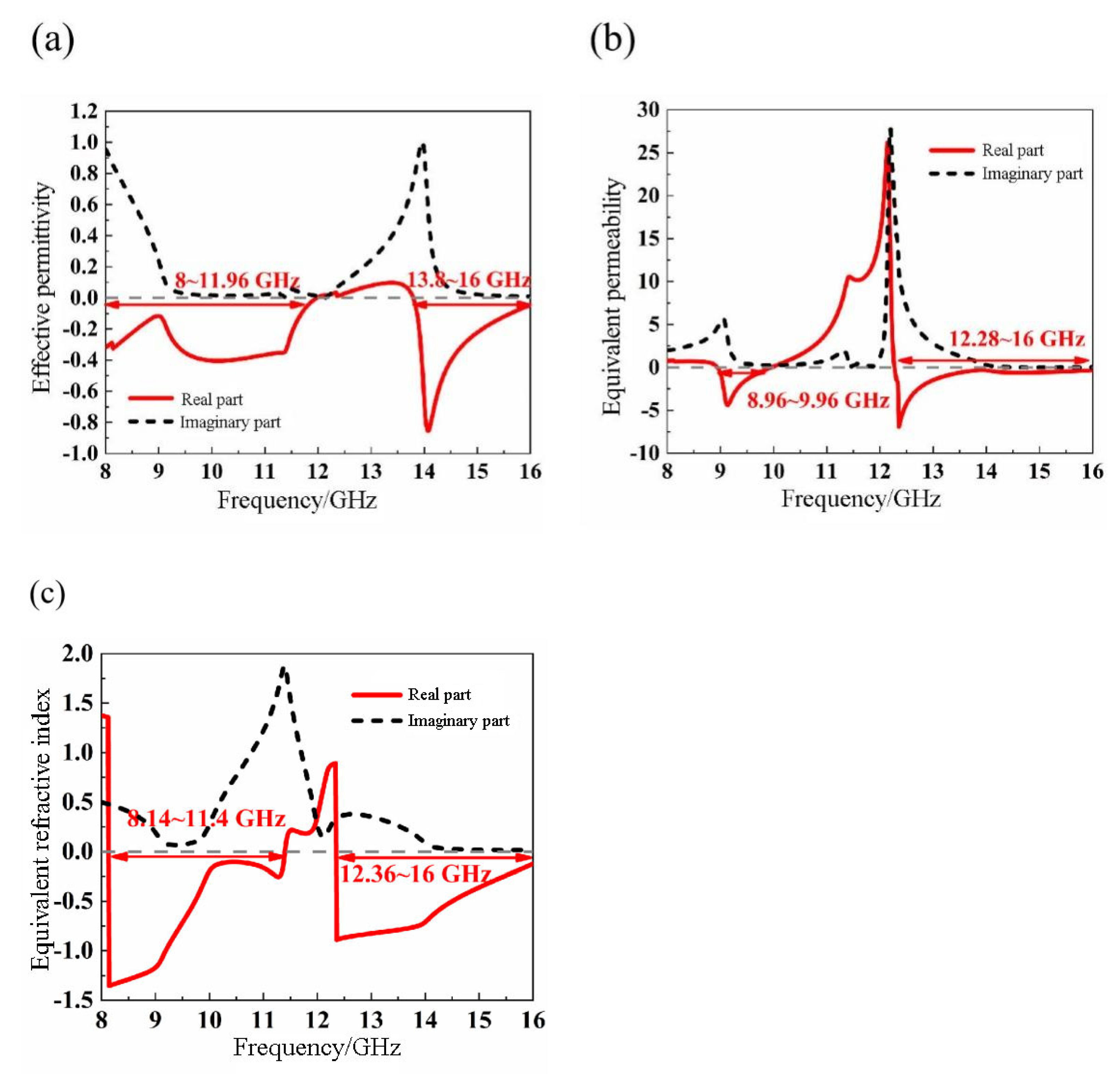
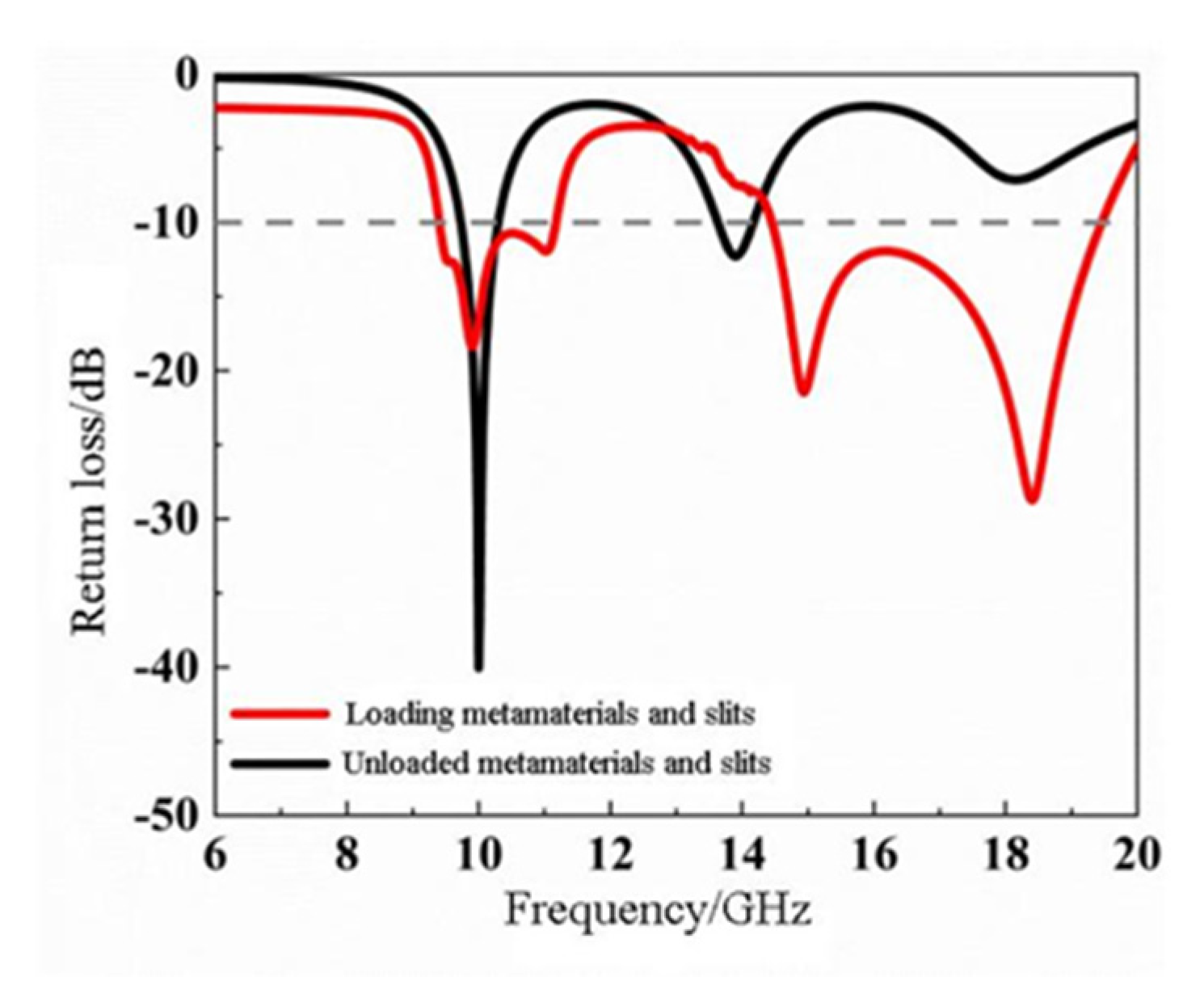

Publisher’s Note: MDPI stays neutral with regard to jurisdictional claims in published maps and institutional affiliations. |
© 2021 by the authors. Licensee MDPI, Basel, Switzerland. This article is an open access article distributed under the terms and conditions of the Creative Commons Attribution (CC BY) license (https://creativecommons.org/licenses/by/4.0/).
Share and Cite
Cui, C.; Ren, Y.; Tao, P.; Cao, B. Microstrip Antenna with High Gain and Strong Directivity Loaded with Cascaded Hexagonal Ring-Shaped Metamaterial. Materials 2021, 14, 7289. https://doi.org/10.3390/ma14237289
Cui C, Ren Y, Tao P, Cao B. Microstrip Antenna with High Gain and Strong Directivity Loaded with Cascaded Hexagonal Ring-Shaped Metamaterial. Materials. 2021; 14(23):7289. https://doi.org/10.3390/ma14237289
Chicago/Turabian StyleCui, Cheng, Yingnan Ren, Pengfei Tao, and Binzhao Cao. 2021. "Microstrip Antenna with High Gain and Strong Directivity Loaded with Cascaded Hexagonal Ring-Shaped Metamaterial" Materials 14, no. 23: 7289. https://doi.org/10.3390/ma14237289




